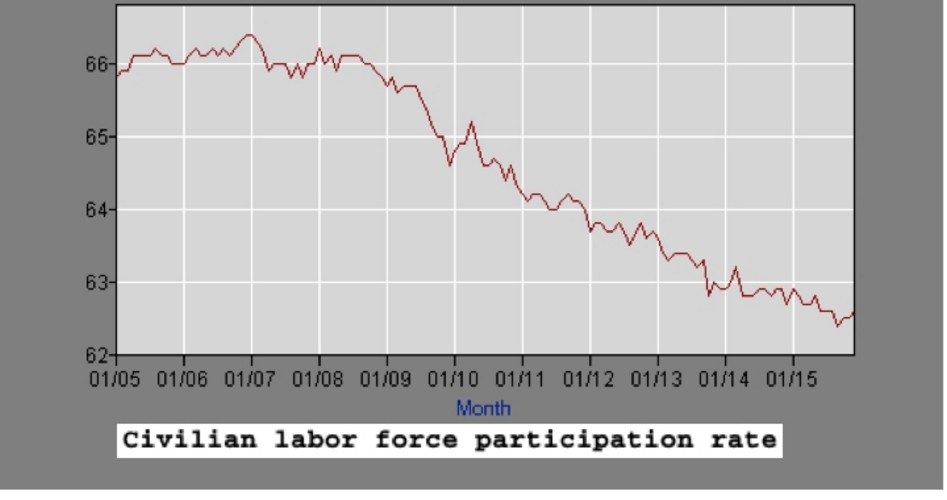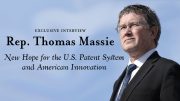
Ten months ago, an NBC News/Wall Street Journal poll foreshadowed the driving forces of the 2016 presidential race by reporting that out of 1,000 adults surveyed, 59 percent indicated a desire for change. As insurgency candidacies have gained strength in both parties, the voters are clearly showing their discontent with business as usual in Washington, D.C.
What’s the reason for such a strong anti-establishment sentiment this election cycle? There are plenty of factors worth mentioning, but near the top of the list has to be the steep decline of America’s labor force participation rate.
Although the Obama administration has loudly touted reports that the U.S. economy has generated 14.1 million new jobs over the past 70 months and now sits at a 5.0 percent unemployment rate, the labor force participation rate has been in virtual free-fall. From March 2010 through December 2015, the percentage dropped from 64.9 percent to a 62.6 percentage, falling to levels not seen since the Carter administration. By contrast, the rate was 67.2 percent when George W. Bush took office in January 2001.
How can the economy currently be producing a “record” number of jobs while the labor force participation rate continues to decline? In order to answer that question, we have to recognize what goes into each calculation.
Per the Bureau of Labor Statistics, the definition of the labor force participation rate is as follows: “The labor force participation rate is the percentage of the population that is either employed or unemployed (that is, either working or actively seeking work).”
The following bullet points are components of the calculation:
• People with jobs are employed.
• People who are jobless, looking for a job, and available for work are unemployed.
• The labor force is made up of the employed and the unemployed.
• People who are neither employed nor unemployed are not in the labor force.
The official unemployment rate cited by the U.S. government is U-3 unemployment, which is defined as follows: “The number of unemployed people as a percentage of the labor force.”
The standard unemployment rate is an extremely narrow calculation that leaves out large swaths of the population — which explains why true employment in the United States is substantially worse than reported. What are the primary factors?
1. The weak economy. Although the economy is technically creating jobs, manufacturing and other higher-paid industries have remained moribund, leaving a large number of potential workers discouraged and out of the labor pool. According to the Bureau of Labor Statistics, there were 663,000 discouraged workers not included in the labor pool as of December 2015.
2. Young people are entering the work force later. With the percentage of individuals possessing at least one advanced degree rising from less than 25 percent in 1995 to over 33 percent today, more and more young workers are delaying entry into the workforce.
3. Disability and government assistance is increasing. Approximately 8.8 million people are on disability insurance, a figure that has doubled over the past 20 years. Likewise, the number of people on one or more means-tested assistance program has been on the rise as well, reaching 21.3 percent of the population in a 2012 report. Although not all individuals on assistance programs are out of the labor force, there is a strong correlation.
4. The aging of America. As the Baby Boomers retire, the pool of available American workers shrinks. On July 22, 2014, Senator Rob Portman (R-Ohio) wrote in the Wall Street Journal that approximately 10,000 people retire each day, a number that has been fact-checked and found to be correct. The roughly 4 million retirees every year dwarfs the 2-3 million new jobs created.
It’s clear that despite the much-ballyhooed 5.0 percent unemployment rate, the U.S. employment situation is in far worse shape than the Obama administration would lead one to believe. At least in part, this unspoken fact explains why polls regarding the direction of the country show we’re on the wrong track by a 30 percent+ margin.
Between bickering politicians, a slow-growth economy, and the declining labor force participation rate, it’s little wonder why 59 percent of polled Americans seek change — which will likely be reflected at the ballot box.
Walter McLaughlin has been in banking and commercial lending for nearly 30 years, specializing in business financing. He manages a small business lending department for a regional bank with offices in Washington, Oregon, Idaho, California, and Utah, winning awards for four consecutive years. He received his Bachelor’s degree in finance from California State University, Northridge in 1986 and graduated from the Stonier Graduate School of Banking in 1997.



